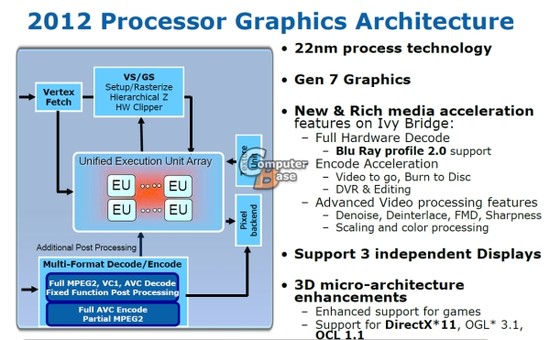Intel dropped a bomb earlier this week when it revealed that after ten years of research it has managed to build a transistor with three dimensions. A breakthrough that will reach the market in the first half of 2012 with the Ivy Bridge architecture. Leaked roadmaps reveal details on the processor and its DirectX 11 graphics processor.
Intel took a step in the right direction when the Sandy Bridge architecture introduced the Intel HD Graphics 3000. Even though the bar was raised substantially it has nothing to compete with AMD. Intel isn’t just behind in performance, but also the features. AMD already has DirectX 11 with its energy efficient APUs, while Intel users has to settle for DirectX 10.1
With the Llano architecture AMD is expected to raise the bar even further and now Intel hopes that Ivy Bridge will close the gap. This will happen by improving the graphics processor in Ivy Bridge with DirectX 11 and 33% more execution units, dubbed EUs.

According to leaked roadmaps from the graphics processor in Ivy Bridge will support a lot of new features. Including hardware acceleration of most formats on the market, and post processing technology for optimized image quality at video playback.
The graphics circuit supports up to three monitors and is better suited for 3D graphics with DirectX 11 support. Intel has also made sure to get support for OpenGL 3.1 and OpenCL, the latter something Apple will surely be happy to see.

We have also had it confirmed that the number of execution units has increased from 12 to 16 in Ivy Bridge. This should lead to a performance boost of around 30%. The graphics portion should also bring more advanced energy saving functions, which together with Intel’s new 22nm Tri-Gate transistors should result in some very efficient circuits.
Source: ComputerBase.de















